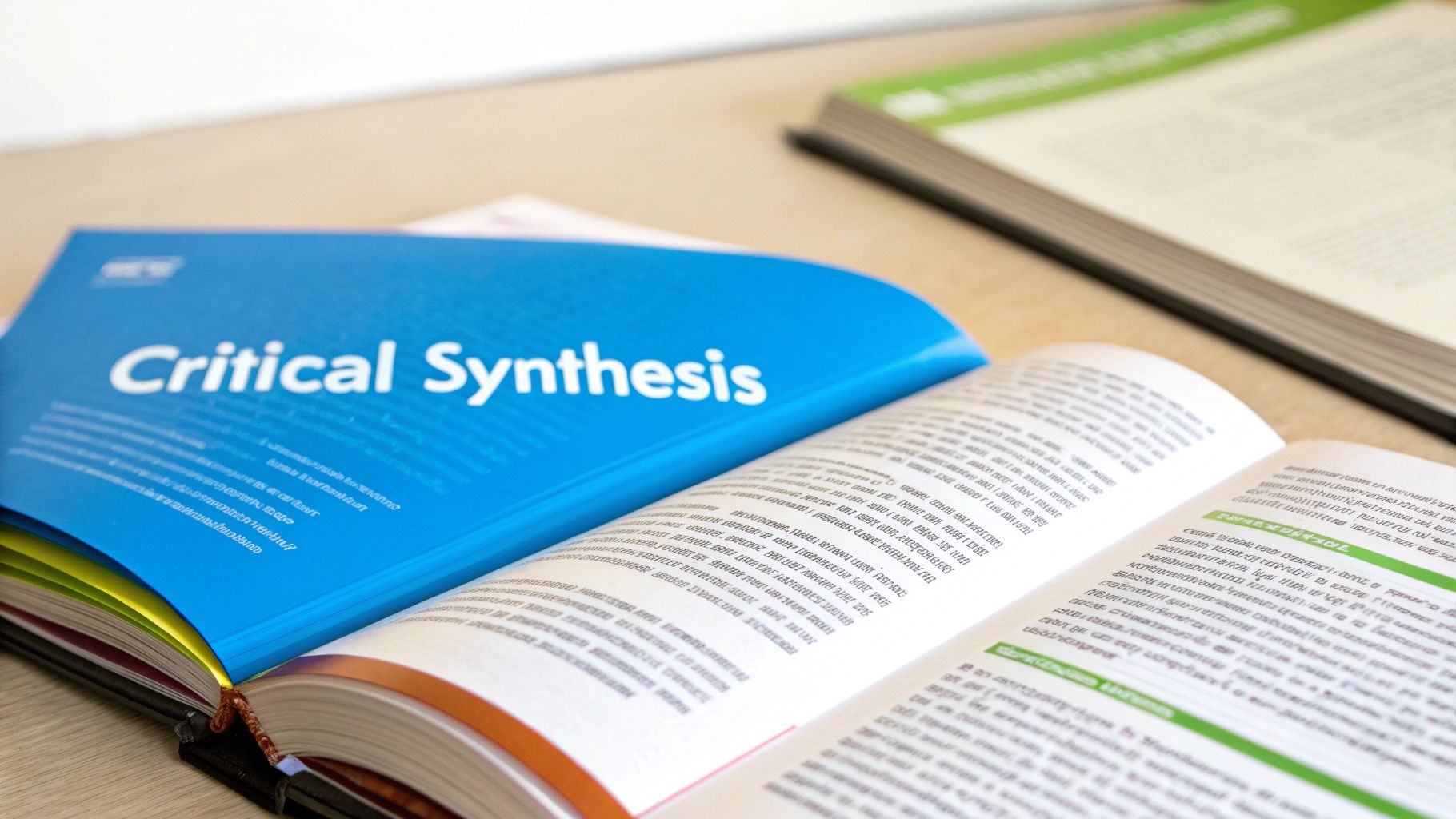6 Indispensable Literature Review Example Types for 2025

The literature review is the backbone of any serious research project, yet many students and academics struggle to move beyond a simple summary of sources. The key to a powerful review is not just what you read, but how you structure and synthesize that information. A well-executed literature review example demonstrates how to identify gaps, build arguments, and position new research within an existing scholarly conversation.
This guide moves beyond theory to provide concrete examples and analysis. We will break down six distinct types of literature reviews, from systematic analyses to narrative explorations, each with a unique purpose and methodology. For each literature review example, we will dissect its structure, analyze its strategic function, and provide actionable takeaways you can apply to your own work. For students undertaking larger academic projects, like a thesis, leveraging comprehensive thesis writing tips can provide a valuable framework for structuring research and incorporating these reviews effectively. Prepare to elevate your research from a simple report to a scholarly masterpiece.
1. The Chronological Approach: Mapping the Evolution of a Topic
A chronological literature review organizes information according to when it was published, tracing the evolution of research on a topic over time. This approach is excellent for demonstrating how an idea, theory, or research area has developed, highlighting key debates, paradigm shifts, and influential studies that changed the field's trajectory.
It’s particularly effective in disciplines where historical context is crucial, such as the humanities, social sciences, or any field showing rapid technological or theoretical progression. By structuring the review this way, you create a narrative that guides the reader from the foundational works to the most current research, clearly positioning your own study as the next logical step.
Strategic Analysis
This type of review isn’t just a simple timeline. A strong chronological review groups sources into broader time periods (e.g., "Early Foundational Studies (1980-1995)," "The Digital Shift (1996-2010)") and analyzes the trends within each era. The goal is to show a progression of thought, not just a list of publications.
Key Tactic: Use transition phrases to link different time periods and explain why the research focus shifted. For example, connect an earlier period of theoretical work to a later period of empirical testing by highlighting a specific technological breakthrough or a seminal paper that challenged existing assumptions.
Actionable Takeaways
- When to Use It: Ideal for topics with a long and evolving research history or for dissertations that need to establish a deep historical context.
- How to Implement: Start by outlining key time periods or significant turning points in your field. Group your sources into these periods.
- Pro-Tip: Focus your analysis on the dialogue between studies across time. A great literature review example using this method would not just say "Smith (1990) found X," but rather, "Smith's (1990) findings directly challenged the prevailing theories of the 1980s, leading to a new wave of research in the subsequent decade."
2. The Meta-Analysis Literature Review: Quantifying the Consensus
A meta-analysis is a highly systematic and quantitative literature review that statistically combines the results from multiple independent studies on a single topic. Instead of just summarizing findings narratively, this powerful approach pools the numerical data to calculate an overall "effect size," offering a more precise and objective conclusion about the research question.
This method is the gold standard in evidence-based fields like medicine, psychology, and public policy, where understanding the true effectiveness of an intervention (e.g., a new drug or educational program) is critical. A meta-analysis can reveal patterns, resolve conflicting results between studies, and identify gaps that a traditional review might miss. For a deeper understanding of how these complex analyses can be structured, you can learn more about synthesizing complex data for a meta-analysis.
Strategic Analysis
The rigor of a meta-analysis comes from its strict, predefined methodology. Researchers must create explicit inclusion and exclusion criteria to select studies, assess the quality of each included study to avoid a "garbage in, garbage out" scenario, and test for statistical heterogeneity (the variation in outcomes between studies). This systematic process minimizes bias and enhances the credibility of the findings.
Key Tactic: Use a forest plot to visually represent the results. This graph displays the effect size and confidence interval for each individual study alongside the combined overall effect. It provides a clear, at-a-glance summary of the evidence, making it a cornerstone of any good literature review example of this type.
Actionable Takeaways
- When to Use It: Perfect for research questions where multiple quantitative studies already exist and you want to synthesize their findings into a single, powerful statistical conclusion.
- How to Implement: Follow the PRISMA (Preferred Reporting Items for Systematic Reviews and Meta-Analyses) guidelines. Use statistical software like R (with the
metaforpackage) or RevMan to manage data and perform calculations. - Pro-Tip: Always conduct a "sensitivity analysis" by re-running your meta-analysis while excluding low-quality studies. If the overall result remains consistent, it strengthens the confidence in your conclusion.
3. The Scoping Review: Mapping the Landscape of a Research Area
A scoping review is a preliminary assessment of the potential size and scope of available research literature. Its primary goal is to map the key concepts, main sources of evidence, and research gaps in a given field without necessarily assessing the quality of the individual studies. This approach is ideal for broad or emerging topics where the body of literature has not yet been comprehensively reviewed.
Popularized by the framework from Arksey and O'Malley, this method helps researchers understand the breadth of a topic, such as the landscape of digital health interventions or the various applications of AI in education. Unlike a systematic review that seeks to answer a specific question, a scoping review asks broader questions like, "What research has been conducted on this topic?" This makes it an invaluable tool for identifying areas ripe for further, more focused investigation.
Strategic Analysis
The power of a scoping review lies in its breadth rather than its depth. It is fundamentally an exploratory exercise. The strategy is not to find a definitive answer but to create a comprehensive map of the existing literature. This map then guides future research, policy, or practice by clearly outlining what is known and, more importantly, what is not.
Key Tactic: Use a structured, transparent, and replicable search methodology, often following guidelines like the PRISMA-ScR (Preferred Reporting Items for Systematic reviews and Meta-Analyses extension for Scoping Reviews). This rigor ensures the "map" you create is credible and provides a solid foundation for subsequent, more detailed reviews.
Actionable Takeaways
- When to Use It: Perfect for new or complex topics, to clarify working definitions and conceptual boundaries, or to identify the types of evidence that would support a future systematic review.
- How to Implement: Follow a clear framework, such as Arksey and O'Malley’s six-stage process, which includes identifying the research question, finding relevant studies, selecting studies, charting the data, and reporting the results.
- Pro-Tip: A high-quality literature review example of this type will be transparent about its limitations, such as search terms used and databases consulted. Clearly state that the goal is mapping, not quality appraisal, to manage reader expectations and position your work as a foundational overview.
4. The Narrative Review: Weaving a Coherent Story from Diverse Sources
A narrative literature review, often considered the traditional approach, synthesizes information from various studies to construct a comprehensive overview of a topic. Instead of adhering to a rigid, systematic protocol, this method emphasizes critical interpretation and storytelling, weaving together findings into a coherent and persuasive narrative about the current state of knowledge.
This approach is highly flexible, making it ideal for broad topics or when the goal is to present a critical perspective or a new conceptual framework. It is commonly found in journal review articles (like those in Nature Reviews), book chapters, and dissertations aiming to provide a rich, contextualized understanding of a field. While powerful, this flexibility requires a disciplined approach to avoid bias and ensure a balanced account. For those looking to streamline their writing process, learning how to humanize AI-generated drafts can be a significant advantage.
Strategic Analysis
The strength of a narrative review lies in its ability to tell a story. It’s not just a summary but an argument. The author guides the reader through the literature, connecting disparate studies, highlighting debates, and synthesizing them to support a specific thesis or point of view. The structure can be thematic, conceptual, or chronological, depending on the story being told.
Key Tactic: Develop a strong thesis statement for your review. This central argument will guide your source selection and organization, transforming a simple summary into a critical analysis that advances the conversation on the topic.
Actionable Takeaways
- When to Use It: Perfect for providing a broad overview of a complex topic, proposing a new theory, or for introductory chapters of a dissertation.
- How to Implement: Start with a clear research question or thesis. Organize your sources thematically around the key arguments you want to make.
- Pro-Tip: A top-tier literature review example of the narrative style will explicitly state its scope and perspective upfront. Acknowledge that your review is one interpretation among many, and clearly define the criteria used to include or exclude sources to enhance its credibility.
5. The Rapid Review: Synthesizing Evidence Under Pressure
A rapid review is an accelerated form of a systematic review, designed to synthesize evidence quickly when time is a critical factor. It employs streamlined methods to provide timely, evidence-based answers for decision-makers, particularly in fast-moving fields like public health and policy, without completely sacrificing scientific rigor.
This approach is invaluable when a full systematic review, which can take months or even years, is not feasible. Examples include assessing the effectiveness of interventions during a pandemic like COVID-19 or evaluating new healthcare technologies for policy consideration. A rapid review condenses the process to deliver actionable insights when they are needed most, making it a pragmatic choice for evidence-informed practice under pressure.
Strategic Analysis
The core of a rapid review is its justification of methodological shortcuts. Unlike a comprehensive review, it might limit the number of databases searched, rely more on abstracts, or use a single reviewer for screening. The key is transparency; the review must clearly state which steps were condensed and why, acknowledging the potential impact on the findings.
Key Tactic: Use a tiered approach to evidence gathering. Start with the highest-quality sources, such as existing systematic reviews and randomized controlled trials. This "best-evidence-first" strategy ensures that even with a shortened timeline, the most robust data informs the conclusions, providing a strong foundation for the analysis.
Actionable Takeaways
- When to Use It: Perfect for urgent situations requiring evidence for policy, clinical guidelines, or emergency response where a traditional review timeline is impractical.
- How to Implement: Clearly define a narrow, answerable question. Predetermine and justify your methodological shortcuts, such as limiting search dates or the number of databases, and use experienced reviewers to ensure efficiency and accuracy.
- Pro-Tip: A powerful literature review example of this type is transparent about its limitations. Explicitly state what was excluded and the potential biases introduced. This honesty builds credibility and helps decision-makers understand the context of your findings, a crucial factor in high-stakes environments.
6. The Umbrella Review (Meta-review): Synthesizing High-Level Evidence
An umbrella review, also known as a meta-review, operates at the highest level of evidence synthesis. Instead of analyzing primary studies, it collects and synthesizes the findings from multiple existing systematic reviews and meta-analyses. This approach provides a broad, high-level overview of evidence across a wide research area, such as the effectiveness of various depression treatments or different cancer screening methods.
This "review of reviews" is powerful for understanding the overall state of knowledge on a topic, identifying consistencies or contradictions in findings across different reviews, and highlighting gaps where no systematic reviews exist. It's a go-to method in fields like evidence-based medicine and public health policy, where decision-makers need a comprehensive summary of a large and complex body of research without getting lost in individual study details.
Strategic Analysis
The core task of an umbrella review is to manage and map the overlap between the included systematic reviews. A researcher must meticulously check which primary studies are included in each review to avoid double-counting evidence. The analysis then focuses on comparing the conclusions, methodologies, and quality of the different reviews to assess the strength and consistency of the evidence.
Key Tactic: Use a quality assessment tool like AMSTAR-2 (A MeaSurement Tool to Assess systematic Reviews) to critically appraise the methodological rigor of each included review. This ensures your synthesis is based on reliable evidence and allows you to weigh the conclusions of high-quality reviews more heavily.
Actionable Takeaways
- When to Use It: Perfect for broad research questions where numerous systematic reviews already exist. It’s ideal for producing authoritative, high-level guidance for policy or practice.
- How to Implement: Start by searching databases specifically for systematic reviews and meta-analyses. Use tools to map the overlap of primary studies and formally assess each review's quality.
- Pro-Tip: A well-executed literature review example of this type explicitly discusses the concordance (agreement) and discordance (disagreement) among the included reviews. It answers the question: "When we look at all the systematic reviews on this topic, what is the consistent message, and where do the disagreements lie?"
Literature Review Types Comparison
| Review Type | Implementation Complexity 🔄 | Resource Requirements ⚡ | Expected Outcomes 📊 | Ideal Use Cases 💡 | Key Advantages ⭐ |
|---|---|---|---|---|---|
| Systematic Literature Review | High – rigorous protocol, multiple databases | High – time (6-24 months), expertise | Comprehensive, unbiased synthesis with high credibility | Established topics needing robust evidence synthesis | Minimizes bias, high reproducibility, gold standard |
| Meta-Analysis Literature Review | High – advanced statistical skills required | High – quality studies, statistical tools | Precise effect size estimates and detection of patterns | Quantitative synthesis of similar studies | Greater statistical power, resolves contradictions |
| Scoping Review | Medium – broader, iterative process | Medium – flexible, diverse evidence | Maps key concepts and research gaps | Emerging or broad research areas | Fast, flexible, identifies gaps |
| Narrative Literature Review | Low – flexible, less structured | Low – depends on author expertise | Broad overview with critical interpretation | Theoretical frameworks, broad topic summaries | Flexible, accessible, expert-driven |
| Rapid Review | Medium – streamlined systematic approach | Medium – fewer databases, single reviewer | Timely evidence synthesis with reasonable rigor | Time-sensitive policy or decision making | Fast, cost-effective, maintains some rigor |
| Umbrella Review (Meta-review) | Very high – synthesis of multiple reviews | High – quality assessment of systematic reviews | High-level overview across systematic reviews | Broad policy/practice decisions across topics | Highest evidence level, efficient synthesis |
Choosing Your Framework and Mastering the Process
Throughout this guide, we have explored a diverse collection of literature review examples, from the rigorous precision of a systematic review to the broad exploratory power of a scoping review. Each type offers a distinct framework, a strategic blueprint designed to answer a specific kind of research question. Seeing a well-executed literature review example in action demystifies the process, transforming an abstract academic task into a tangible, achievable project.
The ultimate goal, regardless of the framework you choose, is to move beyond mere summary. A powerful literature review synthesizes information, identifies critical gaps in knowledge, critiques existing methodologies, and ultimately, constructs a compelling argument that justifies your own research. This process requires not only analytical skill but also a high degree of organizational clarity and writing precision. You are telling the story of the scholarly conversation so far, and your review must be the definitive account that sets the stage for what comes next.
Key Takeaways and Actionable Next Steps
To translate these examples into your own successful project, focus on these core principles:
- Align Your Framework with Your Goal: Match your review type to your research question. A narrow, quantitative question often calls for a meta-analysis, while a broad, emerging topic is better suited for a narrative or scoping review.
- Deconstruct, Then Reconstruct: Break down each source by its core argument, methodology, and key findings. Then, reconstruct these pieces into thematic categories, chronological developments, or methodological debates to build your narrative.
- Critique with Purpose: Don't just list what others have done. Analyze the strengths and weaknesses of the existing research. This critical stance is what elevates your review from a simple report to a scholarly contribution.
Mastering this skill is not just about completing a degree requirement. It is a foundational competency for any serious researcher or professional. It sharpens your analytical abilities and deepens your subject matter expertise. For those delving into the research-intensive aspects of academic writing and project conceptualization, resources on mastering grant writing for research can provide further valuable insights into structuring compelling scholarly arguments. By mastering the literature review, you are equipping yourself to confidently enter and contribute to any professional or academic discourse.
Ready to move from example to execution? A literature review involves synthesizing complex ideas and articulating them with clarity. Word Spinner is designed to help you refine your sentences, enhance your arguments, and ensure your final text is polished and precise. Transform your research notes into a compelling narrative at Word Spinner and build your next literature review with confidence.

